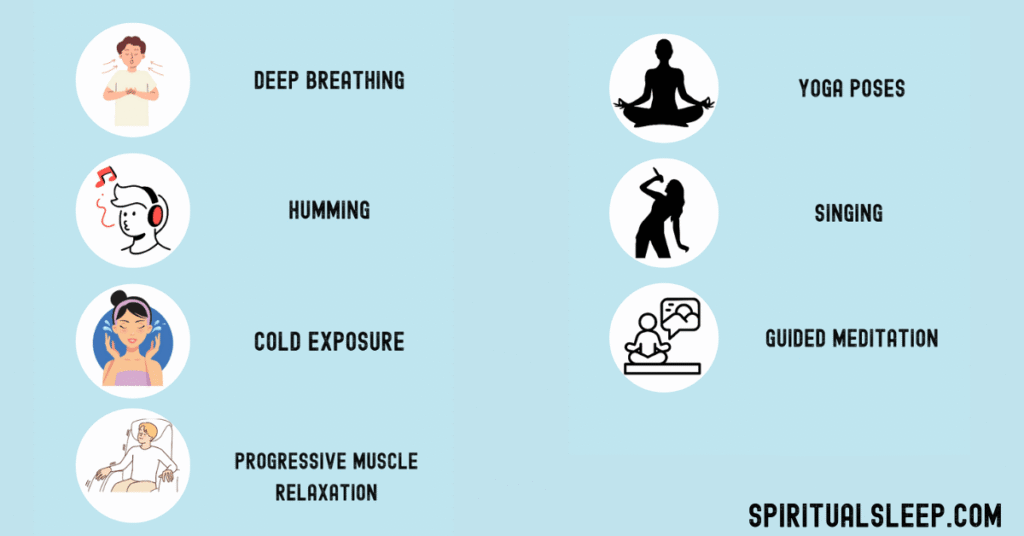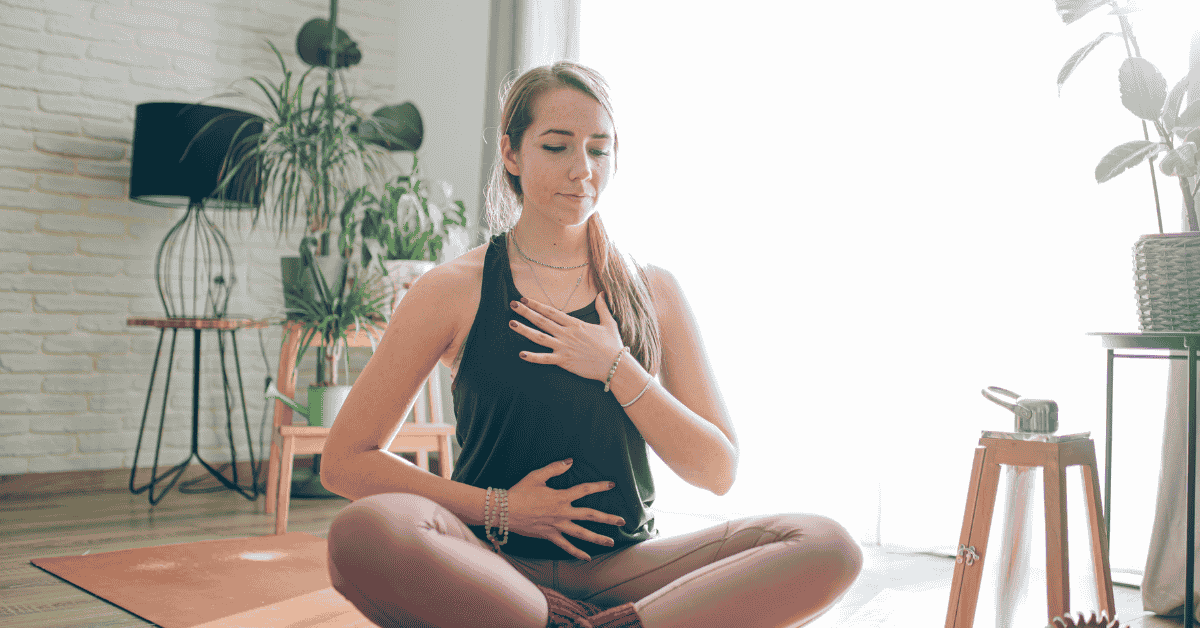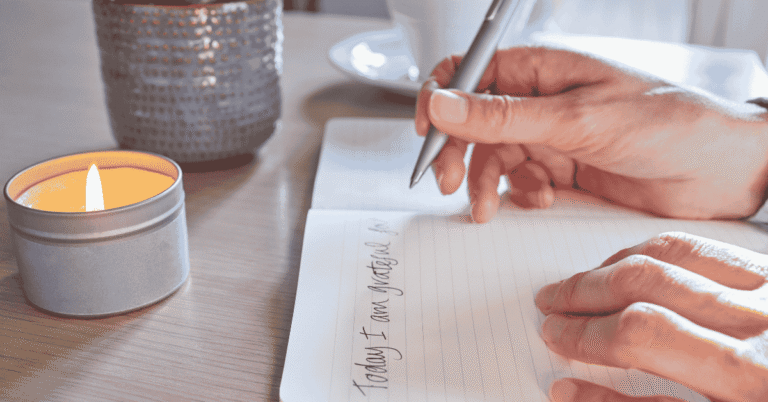Vagus Nerve Exercises for Sleep: A Doctor’s Guide to Restful Nights
Sleep is one of the most critical pillars of health, yet millions of people struggle with insomnia or poor-quality rest. As a medical doctor, I’ve seen firsthand how sleep deprivation affects physical and mental well-being. While there are many strategies to improve sleep, stimulating the vagus nerve has emerged as a natural and effective approach. In this article, we’ll explore vagus nerve exercises for sleep, how they work, and practical ways to integrate them into your routine.
Table of Contents
Why Sleep Matters
Before we dive into vagus nerve exercises, let’s quickly revisit why sleep is so important. Sleep isn’t just about feeling rested, it’s when your body repairs itself, consolidates memories, and regulates hormones. Chronic sleep deprivation can lead to:
- Impaired Cognitive Function: Lack of sleep affects attention, alertness, concentration, reasoning, and problem-solving.
- Increased Risk of Chronic Diseases: Conditions like obesity, diabetes, cardiovascular disease, and hypertension have been linked to insufficient sleep.
- Weakened Immune System: Sleep is crucial for immune function, inadequate rest can lower your resistance to infections.
- Mood Disorders: Chronic sleep deprivation can lead to anxiety, depression, and irritability.
If you’re struggling with sleep, addressing the root cause is essential. One often-overlooked factor is the vagus nerve.
The Role of the Vagus Nerve in Your Body
The vagus nerve is the longest cranial nerve in your body, running from your brainstem down to your abdomen. It connects major organs like your heart, lungs, and digestive tract. This nerve is a key player in the parasympathetic nervous system (PNS), the “rest-and-digest” system that counteracts the stress-driven “fight-or-flight” response.
When your vagus nerve is functioning optimally (a state known as high vagal tone), it helps regulate:
- Heart Rate: A healthy vagus nerve can slow your heart rate during moments of stress.
- Digestion: It promotes digestive processes by stimulating peristalsis and enzyme secretion.
- Breathing: The vagus nerve helps control respiratory rate and depth.
- Emotional Regulation: It plays a role in how we process emotions and respond to stress.
- Sleep Cycles: It influences the transition between wakefulness and sleep.
However, when vagal tone is low,often due to chronic stress or anxiety,it can disrupt these processes and make it harder to relax and fall asleep.
How Does the Vagus Nerve Affect Sleep?
The vagus nerve plays a direct role in calming your body and mind. When stimulated, it activates the parasympathetic nervous system, which:
- Slows Your Heart Rate: A slower heart rate signals to your body that it’s safe to relax.
- Reduces Stress Hormones: It lowers cortisol levels, making it easier to unwind.
- Promotes Relaxation: It triggers the release of neurotransmitters like acetylcholine and GABA that help you feel calm.
- Enhances Digestion: Proper digestion contributes to better sleep by preventing discomfort at night.
By stimulating the vagus nerve through specific exercises, you can create optimal conditions for restful sleep.

Vagus Nerve Exercises for Better Sleep
Here are some proven techniques to stimulate your vagus nerve and improve your sleep quality. These exercises are simple yet powerful tools that you can incorporate into your daily routine.
1. Deep Breathing: The Foundation of Relaxation
Deep breathing is one of the easiest ways to stimulate the vagus nerve and activate your parasympathetic nervous system.
How to Practice:
1. Sit or lie down in a comfortable position.
2. Place one hand on your chest and the other on your belly.
3. Inhale deeply through your nose for 4 seconds, feeling your belly rise (not just your chest).
4. Hold your breath for 4 seconds.
5. Exhale slowly through your mouth for 6 seconds (try pursing your lips as if blowing out a candle).
6. Repeat this cycle for 5–10 minutes before bed.
Why It Works:
Deep breathingincreases oxygen flow to the brain while slowing your heart rate—two key factors in preparing for sleep. This practice also activates the diaphragm, which sends signals to the brain that promote relaxation.
Tips:
– Consider using a breathing app or guided meditation that focuses on breathwork.
– Try counting or using visualization (like imagining filling a balloon) during inhalation.
2. Humming or Chanting: A Surprising Sleep Aid
Humming or chanting stimulates the muscles at the back of your throat, which are connected to the vagus nerve.
How to Practice:
1. Choose a calming sound like “Om,” “Ah,” or simply hum softly.
2. Close your eyes and focus on the vibrations in your throat.
3. Hum continuously for 5–10 minutes during evening relaxation time; you can also do this while meditating.
Why It Works:
The vibrations from humming directly stimulate the vagus nerve while promoting a meditative state that encourages relaxation. This activity also increases nitric oxide production in the nasal passages, which can enhance blood flow and promote overall relaxation.
Tips:
– You can combine humming with deep breathing by inhaling deeply before you start humming.
– Try listening to soothing music while you hum along; this can enhance mood and relaxation further.
3. Cold Exposure: A Refreshing Reset
Cold exposure might not sound appealing before bed, but brief exposure to cold water can stimulate the vagus nerve and calm an overactive mind.
How to Practice:
1. Splash cold water on your face for 30 seconds before bed, you can also use ice cubes wrapped in cloth.
2. Alternatively, try a quick cold shower or immerse yourself in cold water briefly (30 seconds is sufficient).
Why It Works:
Cold exposure activates the vagus nerve by triggering a reflex called the diving response, which slows heart rate and promotes relaxation by shifting blood flow from extremities to vital organs.
Tips:
– If you’re hesitant about cold showers at night, consider doing this practice in the morning as an invigorating start to your day!
– Pair cold exposure with deep breathing afterward to enhance relaxation effects.
4. Progressive Muscle Relaxation (PMR)
PMR involves tensing and relaxing different muscle groups systematically to release physical tension and stimulate the vagus nerve.
How to Practice:
1. Lie down in bed or sit comfortably with eyes closed.
2. Start with your feet—tense them for 5 seconds as tightly as possible; then release completely.
3. Move up through each muscle group (calves → thighs → abdomen → arms → shoulders → face) until you reach your head, hold each tension phase for 5 seconds before releasing.
4. Focus on how relaxed each area feels after releasing tension, visualize stress leaving each muscle group with every exhale.
Why It Works:
PMR calms both body and mind by reducing physical tension while activating parasympathetic responses via the vagus nerve. This technique helps break the cycle of stress-induced muscle tension that often keeps us awake at night.
Tips:
– Consider using guided PMR recordings available online or through apps if you’re new to this practice.
– Combine PMR with deep breathing techniques for enhanced relaxation benefits.
5. Yoga Poses for Relaxation
Yoga combines movement with mindful breathing, an excellent combination for stimulating the vagus nerve.
Best Poses for Sleep:
– Child’s Pose (Balasana):
Kneel on the floor with big toes touching; sit back on heels while stretching arms forward on the ground; this pose promotes gentle stretching of back muscles while calming anxiety.
– Legs-Up-the-Wall Pose (Viparita Karani):
Lie on your back with legs extended up against a wall; this pose encourages venous return from legs while promoting relaxation through inversion effects on circulation.
– Corpse Pose (Savasana):
Lie flat on your back with arms resting beside you; focus on breath awareness; this pose encourages deep relaxation by allowing complete surrender of muscles.
Practice these poses as part of an evening wind-down routine, hold each pose for 5–10 breaths while focusing on slow inhalations/exhalations.
Why It Works:
Yoga not only stretches tight muscles but also calms an overactive mind through breath control, both crucial elements in preparing for restful sleep.
Tips:
– Consider joining a gentle yoga class focused on restorative poses or following along with online videos designed specifically for bedtime routines.
– Use calming essential oils like lavender during practice for added relaxation benefits!
6. Singing or Gargling
Singing or gargling water might seem unconventional but can be surprisingly effective at stimulating the vagus nerve.
How to Practice:
1. Sing along to soothing music during evening downtime; choose songs that resonate with you personally, this will enhance emotional connection!
2. Alternatively, gargle warm water for 30–60 seconds before brushing your teeth at night—focus on feeling vibrations throughout throat area while gargling.
Why It Works:
These activities engage throat muscles connected to the vagus nerve while promoting relaxation through rhythmic activity; singing releases endorphins that further enhance mood!
Tips:
– Consider joining a community choir or singing group if you enjoy social activities, this adds an element of fun!
– Try incorporating chanting into daily routines for instance during morning rituals, to reap benefits throughout day!
7. Guided Visualization or Meditation
Visualization techniques involve imagining calming scenarios that help activate parasympathetic responses via the vagus nerve.
How to Practice:
1. Lie down in bed with eyes closed; take several deep breaths before beginning visualization exercise.
2. Imagine yourself in a peaceful setting (e.g., walking along a serene beach at sunset); focus intently on sensory details like sounds (waves crashing), smells (saltwater), textures (sand beneath feet).
3. Pair this with slow breathing throughout visualization process, inhale deeply as you visualize peaceful elements; exhale any tension or distractions away from mind/body.
Why It Works:
Guided visualization helps shift focus away from stressors while promoting feelings of safety/calmness associated with parasympathetic activation via vagal stimulation!
Tips:
– Use guided meditation apps that offer specific visualizations aimed at relaxation/sleep enhancement, this provides structure if you’re new!
– Experiment with different scenarios until you find what resonates best personally, this enhances effectiveness!
My Experience as a Medical Doctor
As someone who works long hours in healthcare, I’ve experienced my fair share of sleepless nights due to stress or overthinking about patients’ care plans. Incorporating deep breathing exercises into my nightly routine has been transformative, not only for my own sleep but also as a recommendation I confidently share with patients struggling with insomnia or anxiety-induced restlessness.
One patient who struggled with chronic insomnia found relief after integrating humming exercises into her bedtime routine, something I suggested based on emerging research about its impact on vagal tone! She reported feeling calmer within weeks and was able finally get restful nights after years of tossing/turning!
Additional Tips for Success
While vagus nerve exercises are powerful tools for improving sleep quality, they work best when combined with good sleep hygiene practices:
1. Stick to a Consistent Schedule:Go to bed and wake up at the same time every day, even on weekends to regulate circadian rhythms effectively!
2. Limit Screen Time:Avoid screens at least an hour before bedtime as blue light disrupts melatonin production. Consider reading physical books instead!
3. Create a Relaxing Environment:Keep bedroom cool (around 60–67°F), dark (use blackout curtains), quiet (consider white noise machines) conducive environment conducive towards restful slumber!
4. Avoid Stimulants: Limit caffeine intake in afternoon/evening hours—opt instead herbal teas known promote relaxation such chamomile/lavender tea!
5. Exercise Regularly: Physical activity during day promotes better sleep at night, aim for at least 30 minutes moderate exercise most days week!
Medical Disclaimer:This article is based on thorough research, scientific studies, and my personal experience as a medical doctor interested in sleep health. This content is for informational purposes only and should not be considered medical advice. Each individual’s sleep needs and health conditions are unique. I recommend consulting with a healthcare professional or sleep specialist to address specific concerns for better sleep.
Conclusion: Take Control of Your Sleep Naturally
Stimulating your vagus nerve through targeted exercises is a natural way to calm your mind and body before bedtime—no medications required! Whether you choose deep breathing, yoga poses, humming along music or even visualizations these techniques can help achieve more restful nights over time!
Remember, Consistency is key! Incorporate these practices into daily routine gradually but intentionally and enjoy their cumulative benefits not just for sleep but also overall well-being!
References
1. Wu Y et al., “Transcutaneous Vagus Nerve Stimulation Could Improve Sleep Quality,” Brain Sciences, 2022
(https://www.mdpi.com/journal/brainsci)
2. Bretherton B et al., “Vagus Nerve Stimulation: A New Frontier in Treating Insomnia,” Frontiers in Neuroscience, 2020
(https://www.frontiersin.org/journals/neuroscience)
3. D’Elia Assenza E., “8 Vagus Nerve Stimulation Exercises That Help You Relax,” Parsley Health
(https://www.parsleyhealth.com/articles/vagus-nerve-exercises/)
4. “The Science Behind Deep Breathing,” Harvard Health Publishing
(https://www.health.harvard.edu/mind-and-mood/relaxation-techniques-breath-control)
5. “How Yoga Stimulates Your Parasympathetic Nervous System,”https://pmc.ncbi.nlm.nih.gov/articles/PMC9648241





https://t.me/s/iGaming_live/4866